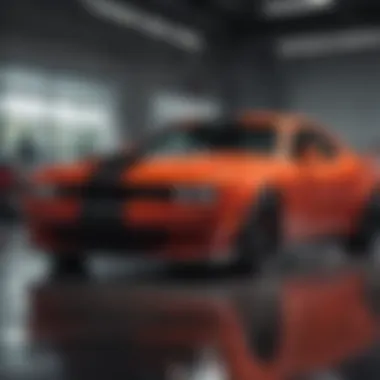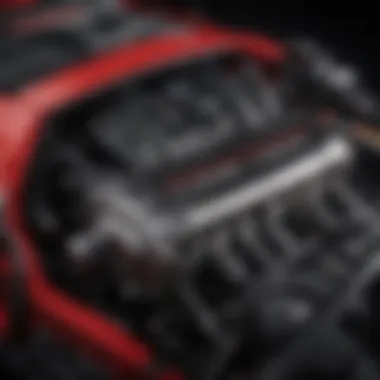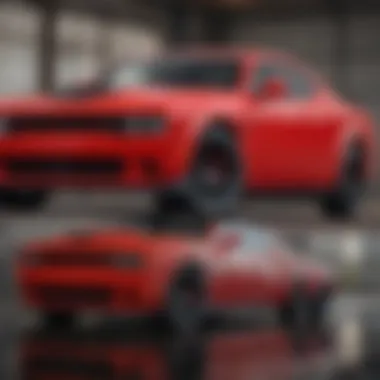Cost Analysis of the 2020 Dodge Hellcat


Intro
The power-packed 2020 Dodge Hellcat reigns supreme in the automotive world, a symbol of performance and luxury combined. For enthusiasts and potential buyers alike, understanding the financial implications of owning such a muscular machine is critical. This analysis sets the stage to dive into the costs associated with purchasing, owning, and maintaining this beast—with emphasis on how various factors influence its market price.
The allure of the Hellcat stems from its engineering marvel and fierce aesthetics. But beneath the hood lies a complex pricing structure. So, this narrative takes a close look at the base cost of the Hellcat and the myriad of additional expenses that may spring up along the journey of ownership.
To navigate the financial waters here, we’ll look closely at the base models, dive into the trim levels that sweeten the pot, and evaluate the role dealer markups play in the final sticker price. On top of that, maintenance and ownership considerations will be dissected, all while keeping an eye on resale value—because, let’s be honest, every car enthusiast has wondered how well their investment will hold up over time.
Intro to the Dodge Hellcat
When discussing high-performance vehicles, the 2020 Dodge Hellcat reigns supreme. This beast of a car has carved out a niche in the automotive world that few can touch, both in terms of raw power and desirability. Understanding the Hellcat is crucial for anyone looking to dive deep into the costs associated with it, whether you're a car aficionado, a potential buyer, or simply someone fascinated by automobile engineering.
Overview of the Dodge Hellcat Concept
The Dodge Hellcat is not just another car; it’s a statement. Introduced as a way to push the boundaries of what's possible in muscle cars, it embodies American automotive heritage with a modern twist. At its core lies a supercharged 6.2-liter HEMI V8 engine that delivers a staggering amount of horsepower, making it one of the most potent vehicles on the market. Besides its heart, the Hellcat features aggressive styling that catches the eye from every angle, lending credence to its formidable reputation.
Key Features of the Hellcat Include:
- Exceptional Performance: The acceleration and top speeds are jaw-dropping, turning the car into a track-worthy machine.
- Heritage and Modernity: The design pays homage to its predecessors while incorporating today’s technology.
- Customizable Options: Buyers are not just getting a car; they’re buying a canvas for customization, making every Hellcat unique in some way.
In essence, the Dodge Hellcat fuses nostalgia with cutting-edge engineering to create an iconic presence on the road.
The Hellcat's Place in the Automotive Landscape
Positioned as a flagship model within the Dodge lineup, the Hellcat doesn't just compete; it dominates. Its rivals may include models from Chevrolet and Ford, but the Hellcat's unique blend of power, performance, and style sets it apart. In a world where hybrids and electric cars are rising, the Hellcat presents a thrilling counterpoint, igniting the passion of driving enthusiasts who cherish the growl of an internal combustion engine.
Some Notable Comparisons:
- Chevrolet Camaro ZL1: While it packs a punch, many argue that the Hellcat offers a more visceral driving experience.
- Ford Mustang Shelby GT500: Known for its performance, it slightly trails when it comes to raw horsepower.
The Hellcat's presence is not just about numbers. It represents a lifestyle choice; owners often see it as a performance artist rather than merely another vehicle in their garage. For many, it’s a durable investment in fun and excitement. This aspect will inevitably feed into our cost analysis, as the vehicle's appeal greatly influences its market price.
Base Price of the Hellcat
Understanding the base price of the 2020 Dodge Hellcat is crucial for potential buyers who are weighing their options in the high-performance vehicle market. The base price serves as the foundation on which all other costs are built, influencing financing decisions and overall budget considerations. Being well-informed about this starting figure helps car enthusiasts and casual buyers alike critically evaluate whether the Hellcat's features justify its cost.
The Hellcat line, including both the Challenger and Charger variants, appeals to those who desire power without compromising on style or comfort. Knowing the base pricing allows consumers to navigate the various trims and optional features with clarity. It also aids in setting expectations for what they can get for their money.
Manufacturer's Suggested Retail Price
The Manufacturer's Suggested Retail Price (MSRP) for the 2020 Hellcat typically starts around $60,000. This MSRP is not merely a sticker price but rather the proposed value set by the manufacturer, reflecting the vehicle's features and capabilities. It's essential because it gives consumers a baseline from which they can analyze market offers.
However, drivers should keep in mind that this figure can dramatically change based on various factors like geography, dealer incentives, and additional features. Therefore, while $60,000 is a decent starting point, shoppers will often find prices that stray well above this, especially when considering market demand and special editions.


Differences Across Trim Levels
When it comes to the 2020 Dodge Hellcat, understanding the variations in trim levels can significantly affect the total cost. The Hellcat line is known for its robust performance, yet each variant comes with distinct features and pricing.
Challenger Hellcat
Focusing on the Challenger Hellcat, this muscle car stands as a hallmark of performance and nostalgia. It brings a unique blend of power and style, favored for its classic muscle car aesthetics. The Challenger boasts a powerful supercharged 6.2-liter V8 engine, offering an exhilarating 707 horsepower. What really sets it apart is its comfort and technology suite, including high-performance brakes and an advanced infotainment system.
One of the key characteristics of the Challenger Hellcat is its direct connection to its heritage, capturing the excitement of cruising down a highway. Many buyers opt for it not only for its spec sheet but also for its striking looks and reputation.
However, the Challenger’s weight can be a disadvantage when compared to lighter competitors. It may not handle as sharply on tight corners, making it feel less agile. Still, for straight-line speed enthusiasts, this trade-off often seems negligible.
Charger Hellcat
Meanwhile, the Charger Hellcat offers a different experience. As a four-door sedan, it blends practicality with the raw power that Dodge is known for. The Charger also comes equipped with the same powerful supercharged V8 engine, generating the same 707 horsepower, but with the added functionality of a family-friendly design.
This model appeals to those who need space for passengers or luggage, yet still crave horsepower that brings it neck-and-neck with sports coupes. The Charger Hellcat’s spacious interior does not come at the cost of performance; it features advanced technology and safety systems that cater to everyday driving needs.
Nonetheless, some may argue that the added weight from its full-size design could slightly hinder its performance compared to the Challenger, particularly in high-speed maneuvers. Yet, for many, the practicality of the Charger combined with blistering speed is an enticing package.
Factors Affecting Cost
Understanding the elements influencing the cost of the 2020 Dodge Hellcat is crucial for any buyer in today’s competitive market. Purchasers need to keep an eye on several key factors that not only determine the base price but can also affect the final amount they pay at the dealership. Things such as demand trends, geographic pricing, markup by dealers, and available incentives play a significant role. Each of these factors holds importance, not just in establishing upfront costs but also in predicting long-term ownership expenses. Let’s delve deeper into these factors.
Market Demand Trends
The automotive industry often sees fluctuations in demand, and the 2020 Dodge Hellcat is no exception. When interest soars for high-performance vehicles, prices can rise accordingly. The allure of its power and performance means that many enthusiasts are keen to own one. As the saying goes, "when the demand rises, the price follows suit."
For instance, during the 2020 launch, the Hellcat generated considerable buzz, leading to higher prices in the market due to scarcity. This is particularly evident in collector circles, where limited availability often results in a bidding war during resale. The cyclical nature of demand—high during new releases and tapering off later—affects how much buyers should anticipate paying. Understanding the marketplace can help in timing your purchase.
Geographical Pricing Variations
Location plays a vital part in the cost of a Dodge Hellcat. Prices can vary significantly from region to region, influenced by factors such as state taxes, local market conditions, and vehicle delivery expenses. For example, a Hellcat might be more expensive in states with higher taxes and fees. In contrast, areas with a surplus of dealerships may offer more competitive pricing due to increased competition.
Moreover, certain parts of the country develop reputations for favoring specific vehicle types. In the Midwest, for instance, buyers might find better deals on muscle cars compared to coastal populations that lean more toward sedans or electric vehicles. When considering purchasing the Hellcat, it's beneficial to not only scout out local dealerships but possibly widen the search to neighboring states, where prices may be more favorable.
Dealer Markups
When purchasing a vehicle like the Dodge Hellcat, shop visits might come with a sticker shock due to dealer markups. Aftermarket dealer behavior often leads to inflated prices above the manufacturer's suggested retail price. These dealers may take advantage of the vehicle's popularity or low inventory to increase profits.
Understanding this practice is essential. Markups can range anywhere from a few thousand dollars to significantly higher amounts under high demand. Buyers should prepare to negotiate, bringing evidence of competitive pricing from nearby dealers to leverage better deals. Sometimes, a dealership may be eager to move inventory and will be flexible, especially if a competitor has a similar model priced lower. This negotiation skill can be a beneficial asset.
Incentives and Discounts


While the price tag on a Hellcat might seem daunting, buyers should also explore whether any incentives or discounts are available. Manufacturers and dealerships occasionally offer cash back, financing options, or trade-in bonuses which can reduce the overall cost.
There are seasonal promotions as well, such as holiday sales or end-of-year clearances that can make owning a Hellcat more financially accessible. Staying informed about these opportunities can make a difference in your overall price. Furthermore, leasing options can often present lower monthly payments versus the outright purchase, making it a favorable alternative for some buyers.
"Every dollar counts, especially when investing in a premier vehicle like the Dodge Hellcat. Do your homework to maximize savings!"
By examining these critical aspects, prospective buyers can navigate the financial landscape of owning the 2020 Dodge Hellcat with a level of knowledge that leads to a more informed purchasing decision. It's a considerable investment, and understanding the factors influencing pricing is an integral part of the journey.
Additional Costs Associated with the Hellcat
When considering the purchase of a high-performance vehicle like the 2020 Dodge Hellcat, potential buyers should not just focus on the sticker price. The allure of horsepower and speed is undeniable, but there are additional expenses that can significantly affect the overall cost of ownership. Understanding these costs is crucial because they can easily catch new owners off guard.
The essence of these additional costs generally revolves around two main categories: maintenance and insurance. Each of these areas has its nuances that play a vital role in the Hellcat ownership experience. If you’re serious about investing in this muscle car, knowledge of these expenses might just save you a few headaches down the road.
Maintenance and Service Expenses
Owning a Dodge Hellcat, with its supercharged HEMI engine, naturally entails unique maintenance and service requirements. This means you can’t run to just any ol’ mechanic down the street; you’ll likely want someone who's familiar with high-performance vehicles.
- Routine Maintenance: This can include oil changes, brake inspections, and tire rotations. Given the Hellcat's performance capabilities, the frequency and type of maintenance may vary significantly from standard vehicles.
- Performance Parts: If you plan to upgrade or modify the Hellcat, expect to pay a premium for performance parts. For instance, aftermarket exhaust systems or suspension kits can add considerable costs.
- Fuel Consumption: The Hellcat is notorious for its powerful engine, which does not come without its drawbacks – namely, fuel consumption. Regularly filling up the tank can cut into your wallet, particularly if you’re enjoying those highway cruising speeds.
- Warranty: While the Hellcat does come with a warranty, certain performance modifications might void it. Consider the ramifications of this when planning for potential repair costs.
"When evaluating total expenses, don’t forget to consider the specialized care your Hellcat needs over time. It’s not just a car, it’s a lifestyle choice."
Insurance Considerations
Insurance costs are another critical component that can unexpectedly affect your budget. Given the Hellcat's classification as a high-performance vehicle, insurance premiums can be on the higher side compared to regular cars.
- High-Risk Classification: The sheer power of the Hellcat often places it in a higher risk bracket for insurers. This can inflate your monthly premiums significantly.
- Coverage Options: Different insurance providers offer various coverage plans. Some may include specialized coverage for high-performance vehicles, which could influence your choice of provider.
- Driving Record: If you have a clean driving record, you might snag lowerrates; however, that’s not a guaranteed ticket to savings. The vehicle’s reputation for speed and performance can still keep costs elevated.
- Geographical Variance: Where you live also plays a role. Urban owners in densely populated areas may see higher rates than those in rural zones, due to the greater likelihood of accidents and theft.
Before committing to purchasing a Hellcat, prospective buyers should carefully calculate these ongoing costs. It’s not merely about the price tag on the car; ownership includes a holistic view of financial responsibilities. Being informed of these factors allows buyers to approach their dream car with clear eyes, ensuring that excitement doesn’t overshadow reality.
Financing Options
When considering the purchase of a 2020 Dodge Hellcat, understanding the available financing options is crucial. The significance of this aspect cannot be overstated, as it affects not only the monthly budget but also the overall cost of ownership. With the Hellcat being a high-performance vehicle, the financing arrangements you choose can either enhance or complicate your buying experience. Here, we elaborate on loans and leasing, as well as the importance of understanding interest rates when embarking on this financial journey.
Loans and Leasing
When it comes to financing the 2020 Dodge Hellcat, buyers typically have two primary routes: loans and leasing. Each option comes with its own set of benefits and considerations.
- Loans: Opting for a loan means you will own the car outright once the payments are complete. This can be beneficial if you're looking to keep the Hellcat long-term. Generally, loans come with fixed monthly payments and are secured against the vehicle, which can give buyers peace of mind. Moreover, successful ownership can result in a positive impact on credit scores over time.
- Leasing: On the other hand, leasing can be an attractive option for those who love to drive the latest and greatest. With lower monthly payments compared to loans, leasing allows buyers to enjoy a new Hellcat without the hefty price tag. However, it’s important to manage mileage carefully, as exceeding the agreed limit can lead to expensive penalties. Plus, at the end of the lease, you won’t own the vehicle, which might feel like throwing money down the drain for car enthusiasts.
"Deciding between a loan and leasing ultimately hinges on your long-term goals with the Dodge Hellcat. If you crave ownership, a loan might be the way to roll. If you like to keep things fresh, leasing may be beneficial."
Understanding Interest Rates


Interest rates can be the silent adversary in the financing saga. They significantly influence the total amount paid over time, which can be a hefty sum for high-end cars like the Hellcat. Here's how to grasp the complexities:
- Type of Interest Rate: When securing a loan or a lease, buyers can often choose between fixed and variable rates. A fixed rate locks in your interest throughout the term but might not reflect market changes. A variable rate can start lower, but may fluctuate, introducing risk into your budgeting.
- Credit Score Impact: Lenders consider your credit score when determining your interest rate. A higher score generally means a better rate, potentially saving thousands over the life of a loan.
- Duration of Financing: Shorter terms usually mean higher monthly payments but less interest in the long run. Conversely, longer terms may seem easier on the wallet monthly but can lead to paying more overall due to accumulating interest.
In preparing for the financing journey, it's wise to shop around and compare offers from different lenders and dealerships. Understanding these nuances helps to ensure that prospective buyers are not caught off guard and can navigate the financial maze with confidence.
Resale Value and Depreciation
Understanding resale value and depreciation is crucial when it comes to the financial implications of owning a 2020 Dodge Hellcat. For many buyers, especially enthusiasts, the excitement of owning such a powerhouse is often accompanied by considerations of how well their investment will hold up over time. The Hellcat, armed with its supercharged V8 engine, offers thrilling performance, but what does that mean for its value years down the line?
When investing in a vehicle like the Hellcat, potential owners should be aware of a few key elements. Not only does depreciation affect the vehicle's market worth, but it also influences insurance costs and trade-in values. In essence, it can determine how much cash you retain when you decide to move on from your current ride.
Factors Affecting Resale Market
Multiple elements play into how the Hellcat holds its value over time:
- Condition of the Vehicle: Like most vehicles, the better you maintain your Hellcat, the higher its resale value will be. Regular service, keeping it clean, and avoiding modifications can greatly help.
- Mileage: Higher miles on the odometer generally point to greater wear and tear, which can decrease the vehicle's market appeal. Enthusiasts tend to prefer low-mileage cars for their performance capabilities.
- Market Trends: The collector car market can be relatively volatile. The interest in muscle cars, including the Hellcat, can ride the wave of trends. For instance, if the demand for high-performance cars surges, prices can stabilize or even increase.
- Brand Reputation: Dodge has built a reputation for creating high-performance vehicles. The enduring appeal of the Hellcat can contribute positively to its resale value.
"Market trends can shift like quicksand; what’s hot today may not be tomorrow."
- Regional Demand: Some areas have a stronger appetite for muscle cars than others, driving up prices in those markets.
Comparative Analysis with Similar Vehicles
When assessing the resale value of the 2020 Dodge Hellcat, it's beneficial to also look at similar muscle cars to gain perspective.
- Ford Mustang Shelby GT500: This car is often considered a direct competitor. Typically, it holds its value well due to its strong brand heritage and performance aspects. It's not uncommon for it to fetch good prices at resale as collectors are always on the lookout for well-preserved models.
- Chevrolet Camaro ZL1: Another contender in the muscle car sphere, the Camaro ZL1 also manages decent resale, but it often comes down to consumer preference. Each buyer may favor one brand over another based on personal experiences and community perception.
In the end, the Dodge Hellcat might not only compete on the road, but it does so in the resale market as well. While each vehicle's depreciation curve will always come into play, the right care and understanding of market dynamics can help prospective owners navigate their investment wisely.
Final Thoughts for Prospective Buyers
When considering the investment involved with the 2020 Dodge Hellcat, it’s essential for potential buyers to keep a few critical points in mind. The cost of owning a Hellcat isn't limited just to its purchase price; a wider financial landscape needs to be considered. Understanding these nuances will help ensure a fruitful investment, avoiding pitfalls and maximizing joy behind the wheel.
Assessing Long-Term Value
Long-term value can be a fickle beast in the automotive world, especially with a high-performance vehicle like the Hellcat. Many enthusiasts might view this vehicle as a temporary pleasure, but it holds significant potential for appreciation based on certain factors. For example, limited production runs or special editions can elevate a car's standing in the resale market. Since Dodge has a reputation for manufacturing cars that evoke excitement and emotion, the Hellcat may just hold its worth better than other muscle cars of its time.
Additionally, prospective buyers should consider the maintenance costs over time. With a supercharged engine delivering substantial power, regular maintenance becomes crucial. Not only that, parts can be pricier than average due to the specialized nature of performance vehicles. It’s wise to plan ahead and budget for these maintenance needs as part of the overall ownership costs.
As one looks beyond the initial purchase, the driving experience also plays a role. The adrenaline rush provided by the Hellcat might justify a premium for many, adding to its perceived value to the owner. Thus, it’s critical to weigh emotional satisfaction against financial outcomes, because this calculation often differs for each individual.
Making an Informed Decision
When it comes to making a decision about the purchase of a Hellcat, knowledge is the key. With various models and trims available, the depth of information plays a huge role in understanding what you’re getting into. One must consider factors such as potential dealer markups and prevailing market conditions which could lead to different quotes from various dealerships.
Do thorough research into financing options, and don't shy away from negotiating with the dealer. Familiarize yourself with interest rates associated with the car loans to avoid getting into a financial squeeze. Finding the right balance between payments and your earning potential is critical for long-term affordability.
Another element that requires attention is to understand insurance ramifications. Given that insurance costs for performance cars can fluctuate widely, it's important to get multiple quotes before committing to a purchase.
In summation, making an informed decision requires an understanding of the complete financial picture encompassing depreciation, maintenance, insurance, and emotional satisfaction. Adequate consideration of these elements will result in a purchase that aligns well with both financial expectations and personal desires.







